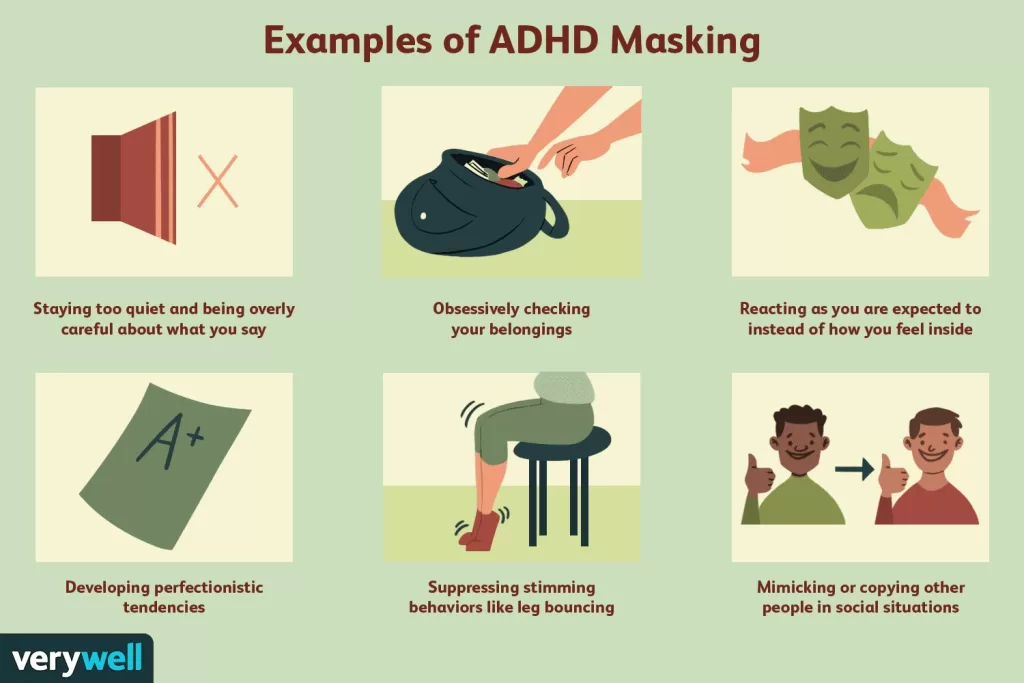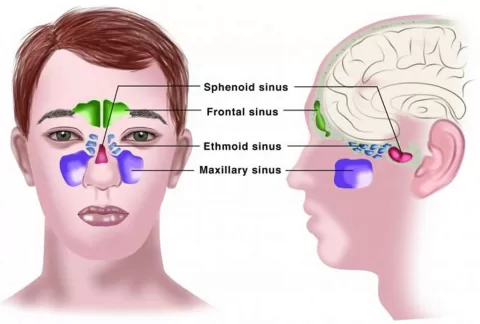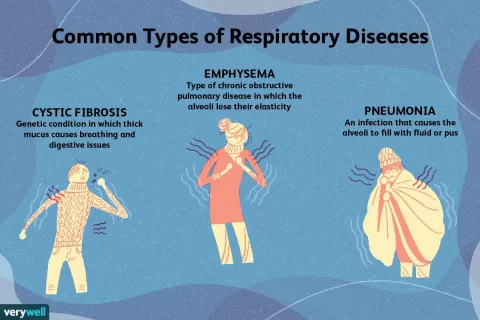ADHD masking refers to the strategies individuals with ADHD use to hide their symptoms and fit into societal expectations seamlessly. This phenomenon, sometimes called “camouflaging ADHD,” often involves behaviors like suppressing hyperactivity, actively managing impulsive tendencies, and mimicking peers’ actions to appear ‘normal.’ Research suggests that these masking behaviors can significantly impact mental health, leading to feelings of isolation and anxiety. Many people with ADHD develop these coping strategies not only to navigate social environments but also as means to combat the stigma attached to ADHD symptoms. By increasing mental health awareness around ADHD masking, we can create a more supportive environment that encourages authenticity and understanding.
Individuals often use various techniques to mask ADHD symptoms, which can also be described as impression management or social camouflage. This practice involves learning to blend in with their peers, often at the cost of their true selves. Many experience internal conflicts when they feel compelled to behave contrary to their natural instincts, a struggle frequently unnoticed by others. Specific masking techniques can include mimicking the behavior of neurotypical individuals or suppressing traits that deviate from social norms. Understanding these masking strategies is crucial for fostering empathy and providing effective ADHD coping strategies that allow individuals to express their true selves.
Understanding ADHD Masking: Definition and Overview
ADHD masking refers to the strategies individuals with Attention Deficit Hyperactivity Disorder (ADHD) employ to conceal their symptoms and fit into social settings. Often termed as ‘impression management’, it encompasses behaviors that include mimicking traits traditionally associated with neurotypical individuals. This practice not only aims to project an image of normalcy but also to escape the stigma attached to ADHD. Individuals may adopt these masking behaviors in various environments, such as workplaces, classrooms, or social gatherings, often to avoid drawing negative attention.
The phenomenon of ADHD masking was explored by psychologist Russell Barkley. He estimated that about one-third of individuals with ADHD engage in these behaviors. It’s essential to recognize that while masking can temporarily enhance social acceptance, it can lead to significant emotional exhaustion and internal conflict. Many people mask their ADHD symptoms due to fear of judgment or misunderstanding, failing to acknowledge the true nature of their experiences.
Common ADHD Masking Behaviors
ADHD masking brings about a range of behaviors that help individuals blend in with their peers. These masking behaviors may include suppressing outward signs of hyperactivity by adopting an overly calm demeanor or meticulously structuring their interactions to avoid revealing their internal chaos. Common examples can include excessive silence in group discussions to prevent speaking out of turn or carefully planning outfits and personal items to project an image of organization and control.
Another prevalent form of masking is the act of maintaining extreme focus during tasks, often at the expense of one’s own comfort. For instance, some individuals may choose to write down everything meticulously in meetings, which helps them cope with memory lapses linked to ADHD. However, these coping strategies can sometimes be detrimental; they add pressure to perform flawlessly, ultimately leading to feelings of inadequacy when expectations are not met.
The Historical Context of ADHD Masking
Historically, ADHD masking has not been extensively studied, though its implications are increasingly recognized within the field of mental health. Barkley’s work shed light on how many individuals with ADHD often engage in these behaviors from a young age, feeling the burden of conforming to societal norms. This continuous strain can make it hard for those affected by ADHD to seek help, as they may believe they have successfully concealed their struggles.
Moreover, the hesitancy to discuss ADHD masking points to a broader need for increased awareness and understanding of the condition itself. Many healthcare providers might overlook the importance of discussing these behaviors during assessments, leading to underdiagnosis and untreated conditions. This lack of dialogue fosters a cycle of misunderstanding, where those with ADHD feel compelled to continue masking their symptoms for fear of stigma.
The Consequences of ADHD Masking
Engaging in ADHD masking can lead to various adverse effects on an individual’s mental health. When symptoms are concealed, it not only delays proper diagnosis but also perpetuates the cycle of misunderstanding and stigma. Many who mask their ADHD may develop depression or anxiety due to the stress of constantly pretending to function normally, exacerbating their symptoms as they struggle alone.
Additionally, the phenomenon can result in a profound sense of impostor syndrome, where individuals doubt their authenticity in both personal and professional lives. Continually reshaping oneself to fit external expectations creates an internal disconnect that can have long-lasting ramifications on self-esteem and overall well-being, leading to crises in identity.
Effective Coping Strategies for ADHD Masking
Recognizing and addressing ADHD masking is vital for improving mental health and overall quality of life. To create a healthier relationship with their symptoms, individuals can begin by differentiating between constructive and harmful coping strategies. For instance, employing organizational skills can be beneficial while striving for perfection might lead to more stress and frustration.
Moreover, seeking support is pivotal. Connecting with a therapist who understands the nuances of ADHD or joining a support group can provide much-needed community and validation. By sharing experiences with others who face similar challenges, individuals can learn healthier coping techniques and build resilience against the pressures of masking.
The Role of Mental Health Awareness in ADHD Masking
Mental health awareness plays a crucial role in understanding and addressing ADHD masking. As society becomes increasingly informed about ADHD and its manifestations, the stigmatization associated with the disorder diminishes. Raising awareness enables individuals to feel more comfortable discussing their struggles openly, reducing the need for masking behaviors.
Efforts from advocacy groups can amplify the voices of those diagnosed with ADHD, helping to foster an environment where individuals are encouraged to express their authentic selves without fear of judgment. Cultivating such an atmosphere can lead to earlier diagnoses and interventions, ultimately supporting mental wellness.
The Relationship Between ADHD Masking and Substance Abuse
There is a concerning connection between ADHD masking and the potential for substance abuse. Many individuals with ADHD who mask their symptoms experience heightened internal stress and emotional turmoil, which may lead them to seek relief through unhealthy coping mechanisms, including drugs or alcohol. This form of escape inadvertently creates a secondary problem, compounding their struggles.
Research indicates that untreated ADHD symptoms can increase the risk of substance-related issues. As individuals mask their experiences, they may not only remain unaware of their ADHD but also become susceptible to addiction, further complicating their mental health landscape. Addressing ADHD masking behaviors is, therefore, essential in preventing these negative cycles.
Exploring Emotional Repercussions of ADHD Masking
The emotional ramifications of ADHD masking can be profound. Many individuals report feelings of shame and isolation due to their inability to navigate their environment without resorting to these behaviors. As they strive to present a version of themselves that aligns with societal expectations, they often suppress their true feelings, resulting in feelings of loneliness and despair.
Moreover, ADHD masking can create a deep-seated fear of vulnerability. When individuals prioritize conforming to external standards over expressing their realities, they may lose the motivation to seek help or support, leading to severe consequences on their mental health as they continue to struggle in silence.
Building a Supportive Environment for ADHD Individuals
Creating a supportive environment is vital for individuals with ADHD, particularly regarding masking behaviors. Family members, friends, and educators should aim to foster open dialogues about ADHD to cultivate understanding and empathy. Such discussions can demystify ADHD symptoms and reduce misconceptions, ultimately supporting those who might feel the need to mask.
Additionally, promoting inclusivity in social and professional settings can help minimize the pressures that lead to masking. By creating spaces where neurodivergent individuals feel comfortable expressing their true selves, communities can empower those with ADHD to embrace their uniqueness and reduce the crippling need to conform.
Frequently Asked Questions
What is ADHD masking and how does it relate to ADHD symptoms?
ADHD masking refers to the learned behaviors individuals with ADHD adopt to hide their symptoms and appear neurotypical. This coping strategy, also known as camouflaging, allows those with ADHD to navigate social situations more comfortably, though it often leads to internal stress and can conceal true ADHD symptoms from peers and professionals.
How can masking behaviors impact mental health awareness in individuals with ADHD?
Masking behaviors can significantly hinder mental health awareness as individuals with ADHD often hide their struggles. This secrecy can lead to misconceptions about the disorder, delaying diagnosis and treatment, while also increasing feelings of isolation, anxiety, and depression.
What are some common ADHD coping strategies that are related to masking?
Common ADHD coping strategies related to masking include suppressing hyperactivity by mimicking calm behavior, obsessively organizing belongings, and excessively focusing during conversations. These behaviors help individuals manage their symptoms but may also place a strain on their mental well-being.
What are the potential negative consequences of ADHD camouflaging?
ADHD camouflaging can lead to various negative consequences, such as misunderstanding by others regarding the individual’s struggles, increased anxiety due to constantly performing, and the risk of substance abuse as a means of coping with the internal stress that masking creates.
How can individuals recognize and address ADHD masking behaviors?
To address ADHD masking, individuals should reflect on their behaviors, differentiate between healthy adaptations and harmful masking, and seek support from peers or professionals. Connecting with a therapist experienced in ADHD can also help in exploring authentic self-expression and reducing the need for camouflaging.
Are there effective support systems for people dealing with ADHD masking?
Yes, effective support systems include ADHD support groups, both in-person and online communities, where individuals can connect with others facing similar challenges. Engaging with mental health professionals who understand ADHD can also provide valuable coping mechanisms and strategies for managing masking behaviors.
How does ADHD masking contribute to feelings of shame among individuals with ADHD?
ADHD masking often leads to feelings of shame as individuals may feel they are ‘faking’ their way through social interactions or fear being exposed for their struggles. This internal conflict contributes to lower self-esteem and can exacerbate mental health issues.
What role does understanding ADHD masking play in improving ADHD diagnosis and treatment?
Understanding ADHD masking can play a crucial role in improving diagnosis and treatment, as it highlights the complexity of ADHD symptoms. By recognizing these masking behaviors, healthcare professionals can better support individuals in revealing their true challenges and provide appropriate interventions.
What steps can someone take to lessen the impact of ADHD masking in their life?
Individuals can lessen the impact of ADHD masking by learning to identify and express their true emotions, seeking supportive relationships, and finding coping mechanisms that encourage authenticity rather than suppression. Engaging in therapy and participating in ADHD-focused communities can also facilitate this process.
| Key Concept | Description | Examples | Impact | Coping Strategies |
|---|---|---|---|---|
| ADHD Masking | Presenting oneself as if one does not have ADHD; also known as impression management or camouflaging. | Suppressing hyperactivity, mimicking peer behavior, excessive organization. | Delayed diagnosis, increased internal stress, potential for anxiety and depression. | Identify harmful vs. healthy masking, seek therapy, connect with support groups. |
| History and Prevalence | Introduced by Russell Barkley; affects about one-third of those with ADHD; often unrecognized by professionals. | Feeling embarrassed about symptoms, managing to seem ‘normal’. | Individuals may feel misunderstood and struggle to be authentic due to skepticism from others. | Engage in open discussions about symptoms, share experiences in safe spaces. |
| Negative Consequences | Can exacerbate mental health issues; inhibits authentic living. | Forcing calmness, perfectionism, hiding emotions, over-responsibility. | Leads to depression, anxiety, and potential substance abuse. | Acknowledge your unique perspectives; reach out for help when needed. |
| Final Thoughts | Understanding and addressing ADHD masking is crucial for overall well-being. | Ongoing struggle with social conformity and emotional management. | Can foster feelings of inadequacy and the fear of not being loved for one’s true self. | Focus on self-acceptance, find fulfilling relationships, and seek professional guidance. |
Summary
ADHD masking is a crucial topic that highlights how individuals with ADHD often feel the need to present themselves as neurotypical to fit in socially. This behavior can lead to significant internal struggles and stress, as those with ADHD may mask their symptoms to avoid stigma or enhance social acceptance. By understanding the implications of ADHD masking, individuals can begin to foster self-acceptance and seek healthier coping mechanisms, ultimately allowing for a more authentic and fulfilling life.
The content provided on this blog (e.g., symptom descriptions, health tips, or general advice) is for informational purposes only and is not a substitute for professional medical advice, diagnosis, or treatment. Always seek the guidance of your physician or other qualified healthcare provider with any questions you may have regarding a medical condition. Never disregard professional medical advice or delay seeking it because of something you have read on this website. If you believe you may have a medical emergency, call your doctor or emergency services immediately. Reliance on any information provided by this blog is solely at your own risk.







